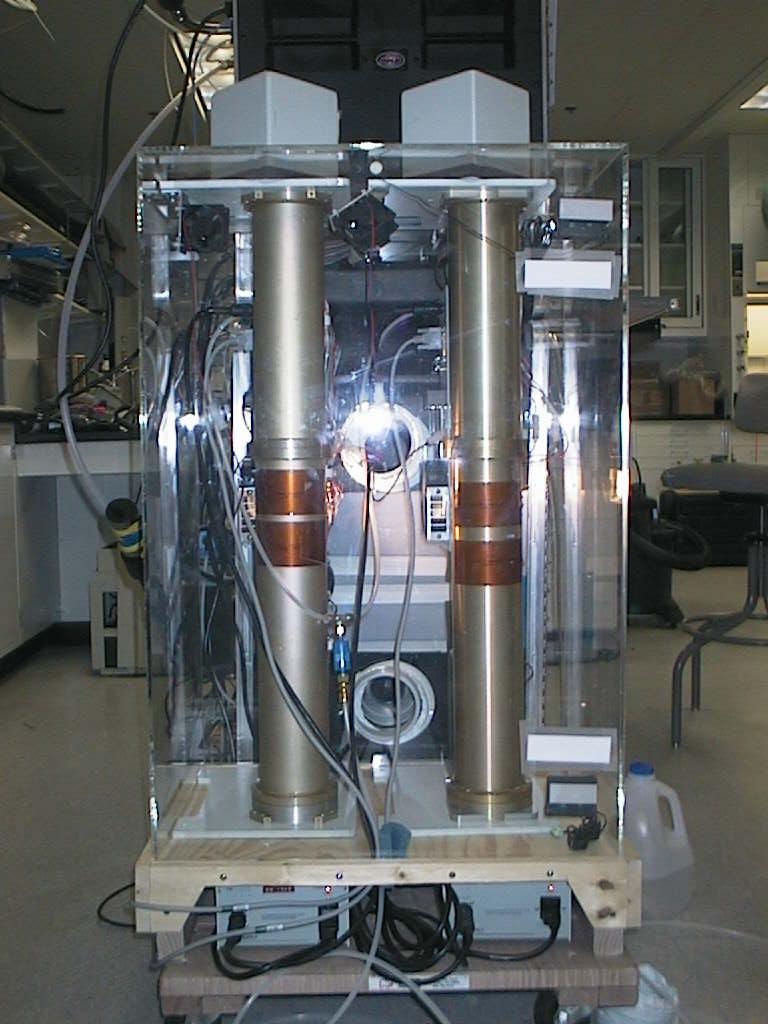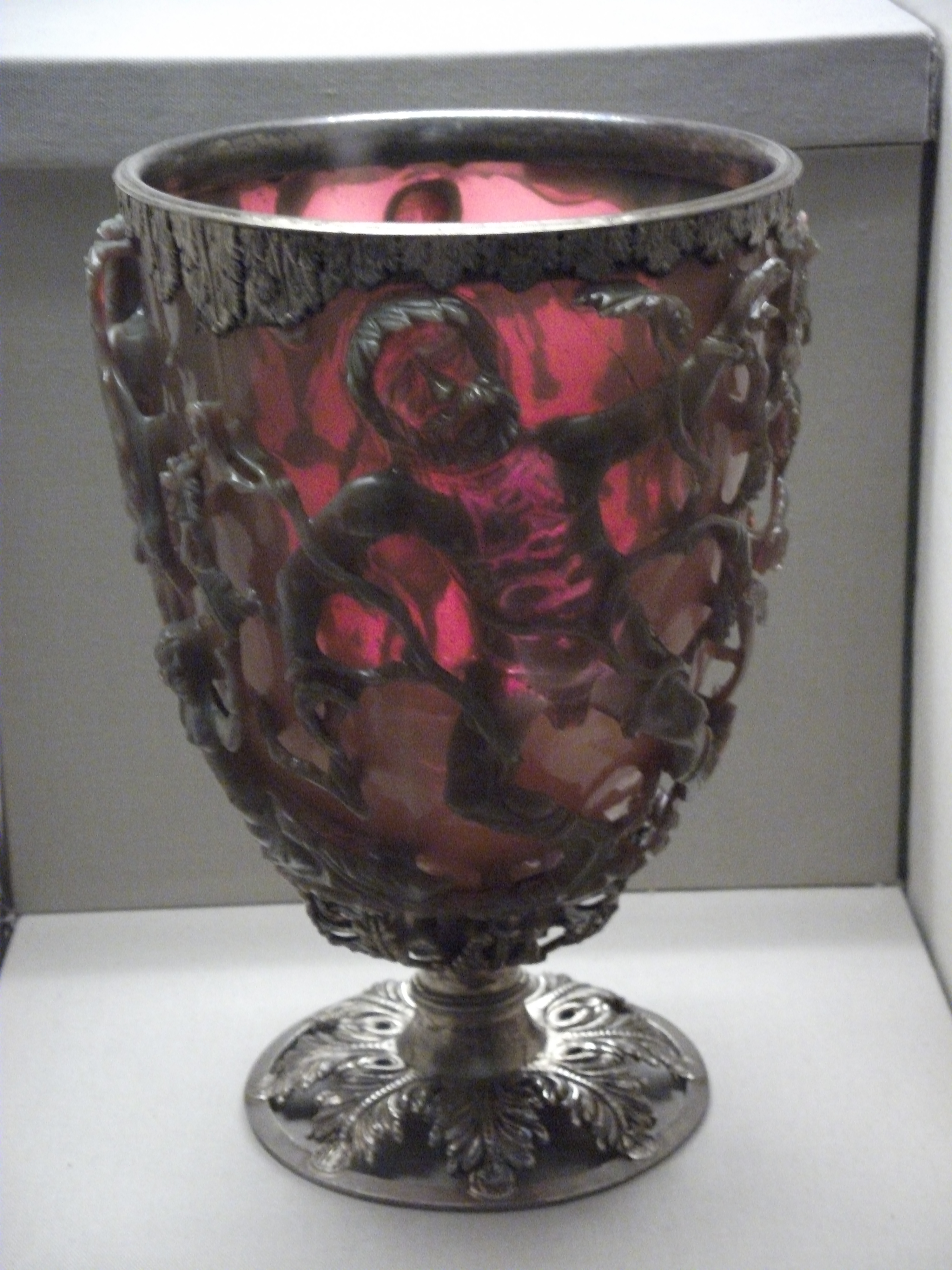|
Tyndall Scattering
The Tyndall effect is light scattering by particles in a colloid or in a very fine suspension. Also known as Tyndall scattering, it is similar to Rayleigh scattering, in that the intensity of the scattered light is inversely proportional to the fourth power of the wavelength, so blue light is scattered much more strongly than red light. An example in everyday life is the blue colour sometimes seen in the smoke emitted by motorcycles, in particular two-stroke machines where the burnt engine oil provides these particles. Under the Tyndall effect, the longer wavelengths are transmitted more while the shorter wavelengths are more diffusely reflected via scattering. The Tyndall effect is seen when light-scattering particulate matter is dispersed in an otherwise light-transmitting medium, where the diameter of an individual particle is in the range of roughly 40 to 900 nm, i.e. somewhat below or near the wavelengths of visible light (400–750 nm). It is particularly applicable to ... [...More Info...] [...Related Items...] OR: [Wikipedia] [Google] [Baidu] |
Nephelometer
A nephelometer or aerosol photometer is an instrument for measuring the concentration of suspended particulates in a liquid or gas colloid. A nephelometer measures suspended particulates by employing a light beam (source beam) and a light detector set to one side (often 90°) of the source beam. Particle density is then a function of the light reflected into the detector from the particles. To some extent, how much light reflects for a given density of particles is dependent upon properties of the particles such as their shape, color, and reflectivity. Nephelometers are calibrated to a known particulate, then use environmental factors (k-factors) to compensate lighter or darker colored dusts accordingly. K-factor is determined by the user by running the nephelometer next to an air sampling pump and comparing results. There are a wide variety of research-grade nephelometers on the market as well as open source varieties. Nephelometer uses The main uses of nephelometers rel ... [...More Info...] [...Related Items...] OR: [Wikipedia] [Google] [Baidu] |
Colloidal Particles
A colloid is a mixture in which one substance consisting of microscopically dispersed insoluble particles is suspended throughout another substance. Some definitions specify that the particles must be dispersed in a liquid, while others extend the definition to include substances like aerosols and gels. The term colloidal suspension refers unambiguously to the overall mixture (although a narrower sense of the word '' suspension'' is distinguished from colloids by larger particle size). A colloid has a dispersed phase (the suspended particles) and a continuous phase (the medium of suspension). The dispersed phase particles have a diameter of approximately 1 nanometre to 1 micrometre. Some colloids are translucent because of the Tyndall effect, which is the scattering of light by particles in the colloid. Other colloids may be opaque or have a slight color. Colloidal suspensions are the subject of interface and colloid science. This field of study was introduced in 1845 by Ital ... [...More Info...] [...Related Items...] OR: [Wikipedia] [Google] [Baidu] |
Nobel Prize For Chemistry
) , image = Nobel Prize.png , alt = A golden medallion with an embossed image of a bearded man facing left in profile. To the left of the man is the text "ALFR•" then "NOBEL", and on the right, the text (smaller) "NAT•" then "MDCCCXXXIII" above, followed by (smaller) "OB•" then "MDCCCXCVI" below. , awarded_for = Outstanding contributions in chemistry , presenter = Royal Swedish Academy of Sciences , location = Stockholm, Sweden , reward = 9 million SEK (2017) , year = 1901 , holder = Carolyn R. Bertozzi, Morten P. Meldal and Karl Barry Sharpless (2022) , most_awards = Frederick Sanger and Karl Barry Sharpless (2) , website nobelprize.org, previous = 2021 , year2=2022, main= 2022, next= 2023 The Nobel Prize in Chemistry is awarded annually by the Royal Swedish Academy of Sciences to scientists in the various fields of chemistry. It is one of the five Nobel Prizes established by the will of Alfred Nobel in 1895, awarded ... [...More Info...] [...Related Items...] OR: [Wikipedia] [Google] [Baidu] |
Cranberry Glass
Cranberry glass or Gold Ruby glass is a red glass made by adding gold salts or colloidal gold to molten glass. Tin, in the form of stannous chloride, is sometimes added in tiny amounts as a reducing agent. The glass is used primarily in expensive decorations. Production Cranberry glass is made in craft production rather than in large quantities, due to the high cost of the gold. The gold chloride is made by dissolving gold in a solution of nitric acid and hydrochloric acid ( aqua regia). The glass is typically hand blown or molded. The finished, hardened glass is a type of colloid, a solid phase (gold) dispersed inside another solid phase (glass). History The origins of cranberry glass making are unknown, but many historians believe a form of this glass was first made in the late Roman Empire. This is evidenced by the British Museum's collection Lycurgus Cup, a 4th-century Roman glass cage cup made of a dichroic glass, which shows a different colour depending on ... [...More Info...] [...Related Items...] OR: [Wikipedia] [Google] [Baidu] |
Gold
Gold is a chemical element with the symbol Au (from la, aurum) and atomic number 79. This makes it one of the higher atomic number elements that occur naturally. It is a bright, slightly orange-yellow, dense, soft, malleable, and ductile metal in a pure form. Chemically, gold is a transition metal and a group 11 element. It is one of the least reactive chemical elements and is solid under standard conditions. Gold often occurs in free elemental ( native state), as nuggets or grains, in rocks, veins, and alluvial deposits. It occurs in a solid solution series with the native element silver (as electrum), naturally alloyed with other metals like copper and palladium, and mineral inclusions such as within pyrite. Less commonly, it occurs in minerals as gold compounds, often with tellurium ( gold tellurides). Gold is resistant to most acids, though it does dissolve in aqua regia (a mixture of nitric acid and hydrochloric acid), forming a soluble tetrachloroaurate an ... [...More Info...] [...Related Items...] OR: [Wikipedia] [Google] [Baidu] |
Carl Zeiss AG
Carl Zeiss AG (), branded as ZEISS, is a German manufacturer of optical systems and optoelectronics, founded in Jena, Germany in 1846 by optician Carl Zeiss. Together with Ernst Abbe (joined 1866) and Otto Schott (joined 1884) he laid the foundation for today's multi-national company. The current company emerged from a reunification of Carl Zeiss companies in East and West Germany with a consolidation phase in the 1990s. ZEISS is active in four business segments with approximately equal revenue (Industrial Quality and Research, Medical Technology, Consumer Markets and Semiconductor Manufacturing Technology) in almost 50 countries, has 30 production sites and around 25 development sites worldwide. Carl Zeiss AG is the holding of all subsidiaries within Zeiss Group, of which Carl Zeiss Meditec AG is the only one that is traded at the stock market. Carl Zeiss AG is owned by the foundation Carl-Zeiss-Stiftung. The Zeiss Group has its headquarters in southern Germany, in the sma ... [...More Info...] [...Related Items...] OR: [Wikipedia] [Google] [Baidu] |
Henry Siedentopf
Henry Friedrich Wilhelm Siedentopf (22 September 1872 in Bremen – 8 May 1940 in Jena) was a German physicist and pioneer of microscopy. Biography Siedentopf worked in Carl Zeiss company from 1899 to 1938. In 1907 he was nominated as the head of the microscopy department. In 1902 the ultramicroscope was developed by Richard Adolf Zsigmondy (1865–1929) and Siedentopf, working for Carl Zeiss AG. The ultramicroscope was suitable for the determination of small particles and became the most important instrument of colloid research in colloid chemistry. In 1925, Zsigmondy received the Nobel Prize for Chemistry also for this work. From 1919 till 1940 he was a. o. Professor for microscopy at the University of Jena The University of Jena, officially the Friedrich Schiller University Jena (german: Friedrich-Schiller-Universität Jena, abbreviated FSU, shortened form ''Uni Jena''), is a public research university located in Jena, Thuringia, Germany. The .... He also worked o ... [...More Info...] [...Related Items...] OR: [Wikipedia] [Google] [Baidu] |
Richard Adolf Zsigmondy
Richard Adolf Zsigmondy ( hu, Zsigmondy Richárd Adolf; 1 April 1865 – 23 September 1929) was an Austrian-born chemist. He was known for his research in colloids, for which he was awarded the Nobel Prize in chemistry in 1925, as well as for co-inventing the slit-ultramicroscope, and different membrane filters. The crater Zsigmondy on the Moon is named in his honour. Biography Early years Zsigmondy was born in Vienna, Austrian Empire, to a Hungarian gentry family. His mother Irma Szakmáry, a poet born in Martonvásár, and his father, Adolf Zsigmondy Sr., a scientist from Pressburg (Pozsony, today's Bratislava) who invented several surgical instruments for use in dentistry. Zsigmondy family members were Lutherans. They originated from Johannes ( hu, János) Sigmondi (1686–1746, Bártfa, Kingdom of Hungary) and included teachers, priests and Hungarian freedom-fighters. Richard was raised by his mother after his father's early death in 1880, and received a comprehensive e ... [...More Info...] [...Related Items...] OR: [Wikipedia] [Google] [Baidu] |
Arthur Whitmore Smith
Arthur is a common male given name of Brythonic origin. Its popularity derives from it being the name of the legendary hero King Arthur. The etymology is disputed. It may derive from the Celtic ''Artos'' meaning “Bear”. Another theory, more widely believed, is that the name is derived from the Roman clan '' Artorius'' who lived in Roman Britain for centuries. A common spelling variant used in many Slavic, Romance, and Germanic languages is Artur. In Spanish and Italian it is Arturo. Etymology The earliest datable attestation of the name Arthur is in the early 9th century Welsh-Latin text '' Historia Brittonum'', where it refers to a circa 5th to 6th-century Briton general who fought against the invading Saxons, and who later gave rise to the famous King Arthur of medieval legend and literature. A possible earlier mention of the same man is to be found in the epic Welsh poem '' Y Gododdin'' by Aneirin, which some scholars assign to the late 6th century, though this is still a ... [...More Info...] [...Related Items...] OR: [Wikipedia] [Google] [Baidu] |
Atmospheric Particulate Matter
Particulates – also known as atmospheric aerosol particles, atmospheric particulate matter, particulate matter (PM) or suspended particulate matter (SPM) – are microscopic particles of solid or liquid matter suspended in the air. The term ''aerosol'' commonly refers to the particulate/air mixture, as opposed to the particulate matter alone. Sources of particulate matter can be natural or anthropogenic. They have impacts on climate and precipitation that adversely affect human health, in ways additional to direct inhalation. Types of atmospheric particles include suspended particulate matter; thoracic and respirable particles; inhalable coarse particles, designated PM, which are coarse particles with a diameter of 10 micrometers (μm) or less; fine particles, designated PM, with a diameter of 2.5 μm or less; ultrafine particles, with a diameter of 100 nm or less; and soot. The IARC and WHO designate airborne particulates as a Group 1 carcinogen. Particul ... [...More Info...] [...Related Items...] OR: [Wikipedia] [Google] [Baidu] |
John Tyndall
John Tyndall FRS (; 2 August 1820 – 4 December 1893) was a prominent 19th-century Irish physicist. His scientific fame arose in the 1850s from his study of diamagnetism. Later he made discoveries in the realms of infrared radiation and the physical properties of air, proving the connection between atmospheric CO and what is now known as the greenhouse effect in 1859. Tyndall also published more than a dozen science books which brought state-of-the-art 19th century experimental physics to a wide audience. From 1853 to 1887 he was professor of physics at the Royal Institution of Great Britain in London. He was elected as a member to the American Philosophical Society in 1868. Early years and education Tyndall was born in Leighlinbridge, County Carlow, Ireland. His father was a local police constable, descended from Gloucestershire emigrants who settled in southeast Ireland around 1670. Tyndall attended the local schools (Ballinabranna Primary School) in County Carlow u ... [...More Info...] [...Related Items...] OR: [Wikipedia] [Google] [Baidu] |






.jpg)

